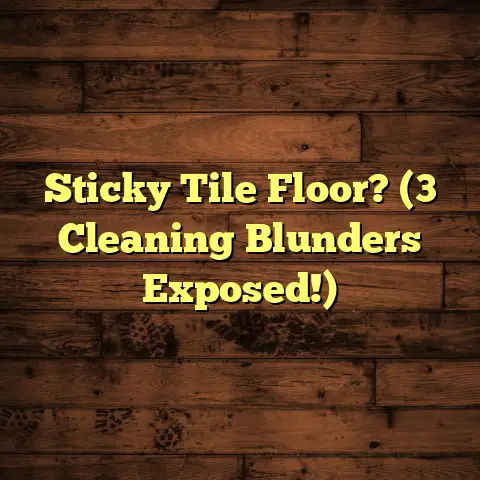Concrete Floor Asbestos? (2 Tests You Must Do!)
And nowadays, everyone’s focused on making their homes more energy-efficient, right?
We’re all about saving money and being kinder to the planet.
But here’s the thing: we can’t just slap on some insulation and call it a day.
We’ve got to think about what we’re using in our homes, too.
Specifically, I’m talking about asbestos.
You might think concrete floors are just durable and low-maintenance.
But if your house was built before the 1980s, there’s a chance asbestos could be hiding in that concrete.
I know, it’s scary!
As we aim for energy savings with better insulation, we need to make sure our homes aren’t filled with harmful stuff like asbestos.
That’s why this article is all about testing for asbestos in concrete floors.
We’ll talk about the risks and the two essential tests you must do.
Let’s get started, and I’ll guide you through everything you need to know.
Section 1: Understanding Asbestos and Its Health Risks
1. What is Asbestos?
So, what exactly is asbestos?
Well, it’s a naturally occurring mineral that was super popular in construction for a long time.
We’re talking way back into the late 19th century!
It’s strong, flexible, and doesn’t burn – perfect for all sorts of building materials.
But here’s the kicker: it’s also incredibly dangerous when inhaled.
There are different types of asbestos, but the ones you’re most likely to find in flooring are:
- Chrysotile (white asbestos): The most common type, often used in floor tiles and cement sheets.
- Amosite (brown asbestos): Stronger than chrysotile, it was often used in insulation boards and ceiling tiles.
I’ve personally seen both during renovations, and let me tell you, it’s not something you want to mess with.
2. Why Was Asbestos Used in Concrete Flooring?
Okay, so why did everyone love asbestos so much?
It all comes down to its amazing properties.
Asbestos is a fantastic fire retardant, adds strength, and even provides some insulation.
This made it a go-to for things like floor tiles, adhesives, and even the concrete itself.
In concrete, asbestos fibers were added to increase its strength and durability.
They would also reduce cracking.
Think of it like adding rebar to concrete, but with tiny, hazardous fibers.
But, thankfully, people started realizing the dangers, and regulations began to pop up.
The U.S. started restricting asbestos use in the 1970s, and many countries have since banned it completely.
However, it’s still legal in the US, with some restrictions.
3. Health Risks Associated with Asbestos Exposure
This is where things get serious.
Asbestos exposure can lead to some really nasty diseases.
When you breathe in asbestos fibers, they can get lodged in your lungs.
Over time, this can cause:
- Asbestosis: Scarring of the lung tissue, making it hard to breathe.
- Mesothelioma: A rare and aggressive cancer that affects the lining of the lungs, abdomen, or heart.
- Lung Cancer: Asbestos exposure significantly increases the risk, especially for smokers.
The scariest part?
These diseases can take decades to develop.
This is called the latency period.
You could be exposed to asbestos today and not show symptoms for 20, 30, or even 40 years.
That’s why early detection and prevention are so crucial.
According to the World Health Organization (WHO), approximately 107,000 deaths each year are linked to occupational exposure to asbestos.
This is a sobering statistic, and it underscores the importance of taking asbestos seriously.
Section 2: Why Testing for Asbestos is Crucial
1. The Legal and Financial Implications
Ignoring asbestos isn’t just a health risk.
It can also land you in legal and financial hot water.
As a homeowner or landlord, you have a responsibility to provide a safe living environment.
If you know (or even suspect) there’s asbestos on your property, you’re often legally obligated to disclose it.
Failing to do so can lead to lawsuits and hefty fines.
The cost of asbestos removal can also be significant.
It’s not a DIY job!
You’ll need to hire licensed professionals, which can cost thousands of dollars.
And that’s before considering potential healthcare costs if someone gets sick from exposure.
2. Impact on Property Value
Asbestos can seriously impact your property value.
Think about it: would you want to buy a house knowing there’s a potential health hazard lurking in the floors?
Most buyers will be turned off, or they’ll demand a significant price reduction to cover the cost of asbestos removal.
In many states, you’re legally required to disclose the presence of asbestos to potential buyers.
Hiding it can lead to legal trouble down the road.
Being upfront and addressing the issue head-on is always the best approach.
3. Energy Efficiency and Asbestos
You might be wondering, “What does asbestos have to do with energy efficiency?”
Well, it’s all about creating a healthy and sustainable home.
Removing asbestos isn’t just about health; it’s also about improving indoor air quality.
This can lead to a more comfortable and energy-efficient living space.
Think about it: if you’re constantly battling allergies or respiratory issues, you might crank up the AC or heater to try and feel better.
But clean air and a healthy home environment can reduce the need for excessive energy consumption.
Plus, once the asbestos is gone, you can renovate with safe, modern materials that offer better insulation and energy performance.
It’s a win-win!
Section 3: The Two Essential Tests for Asbestos in Concrete Floors
Okay, let’s get down to the nitty-gritty.
How do you actually test for asbestos in your concrete floors?
There are two essential tests you need to do:
1. Test 1: Visual Inspection and Sampling
First up: the visual inspection.
This is your initial reconnaissance mission.
Look for signs that might indicate asbestos-containing materials.
Here’s what to look for:
- Old floor tiles: Especially 9×9 inch tiles, which were commonly made with asbestos.
- Damaged or crumbling concrete: If the concrete is deteriorating, asbestos fibers could be released into the air.
- Patches or repairs: These could indicate previous asbestos abatement work.
If you spot anything suspicious, don’t start tearing things apart!
That’s the worst thing you can do.
Instead, you’ll need to collect a sample for laboratory testing.
Here’s how to do it safely:
- Gather your supplies: You’ll need a respirator (N-95 or higher), disposable gloves, a plastic bag, duct tape, a utility knife, and a spray bottle filled with water.
- Wet the area: Lightly mist the area you’re sampling with water. This helps prevent fibers from becoming airborne.
- Cut a small sample: Use the utility knife to carefully cut a small piece of the material. Aim for about 1-2 square inches.
- Place the sample in the bag: Seal the bag tightly and label it with the date, location, and a description of the material.
- Clean up: Wipe down the area with a damp cloth and dispose of your gloves and respirator properly.
Important: Always wear protective gear and follow safety protocols when sampling.
If you’re not comfortable doing this yourself, hire a qualified professional.
2. Test 2: Laboratory Analysis
Once you’ve collected your sample, it’s time to send it to a laboratory for analysis.
Here’s what happens at the lab:
The lab technicians will use specialized techniques to identify and quantify any asbestos fibers in your sample.
The two most common methods are:
- Polarized Light Microscopy (PLM): This method uses a special microscope to identify asbestos fibers based on their optical properties.
- Transmission Electron Microscopy (TEM): This is a more sensitive method that can detect even the smallest asbestos fibers.
What to expect from the results:
The lab will provide you with a report that details the type and amount of asbestos found in your sample.
The report will usually state the percentage of asbestos by weight.
Anything above 1% is generally considered asbestos-containing material (ACM).
Timelines:
Lab results typically take a few days to a week, depending on the lab and the type of analysis.
Interpreting the findings:
It’s crucial to consult with a qualified professional to interpret your lab results.
They can explain what the findings mean and recommend the best course of action.
Section 4: What to Do If Asbestos is Detected
Okay, so you’ve tested your concrete floor, and the results came back positive for asbestos.
Don’t panic!
Here’s what you need to do:
1. Immediate Actions to Take
Your first priority is to minimize exposure and prevent the spread of asbestos fibers.
Here’s what to do immediately:
- Seal off the area: If possible, close off the room or area where the asbestos was detected.
- Avoid disturbing the material: Don’t sweep, vacuum, or sand the area. This can release fibers into the air.
- Notify local health authorities: Contact your local health department or environmental agency to report the asbestos.
- Seek professional help: Hire a licensed asbestos abatement contractor to assess the situation and develop a removal plan.
2. Choosing the Right Asbestos Abatement Professional
Choosing the right contractor is crucial.
You want someone who is experienced, qualified, and follows all safety regulations.
Here are some criteria to consider:
- Licensing and certifications: Make sure the contractor is licensed and certified to perform asbestos abatement in your state.
- Experience: Ask about their experience with similar projects.
- References: Check their references and read online reviews.
- Insurance: Verify that they have adequate insurance coverage.
- Safety measures: Ask about their safety protocols and how they protect workers and occupants during the removal process.
Questions to ask potential contractors:
- “Are you licensed and certified to perform asbestos abatement in this state?”
- “How many years of experience do you have?”
- “Can you provide references from past clients?”
- “What safety measures do you take to protect workers and occupants?”
- “How will you dispose of the asbestos waste?”
3. Long-Term Considerations for Homeowners
Once the asbestos has been removed, it’s important to take steps to prevent future problems.
Here are some long-term considerations:
- Ongoing monitoring: Consider having your home tested periodically to ensure that no asbestos fibers remain.
- Renovating with safe materials: When renovating, choose materials that are asbestos-free and environmentally friendly.
- Proper ventilation: Ensure that your home has adequate ventilation to improve indoor air quality.
Conclusion: Prioritizing Safety and Sustainability in Your Home
We’ve covered a lot of ground in this article.
Hopefully, you now have a better understanding of the risks associated with asbestos in concrete floors and how to test for it.
As homeowners, we’re all striving for energy efficiency and sustainability.
But we can’t achieve those goals without addressing potential health hazards like asbestos.
By understanding the risks, conducting the necessary tests, and taking appropriate action, you can safeguard your health and enhance the value and efficiency of your home.
Remember, prioritizing safety and sustainability is an investment in your future and the future of your family.
Thanks for reading, and stay safe out there!





